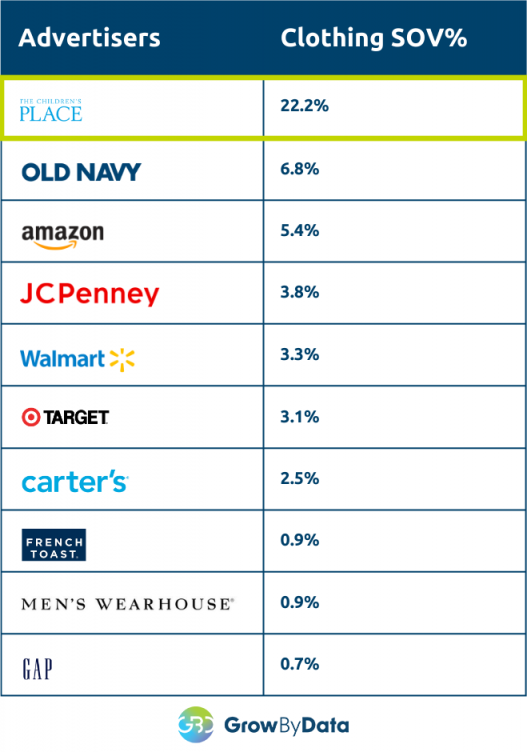This report presents a comprehensive analysis of Google Shopping Ads and Organic SERP data collected between August 23, 2024, and September 9, 2024. Through this data, GrowByData has uncovered key insights into the competitive landscape for the back-to-school season.
The findings show fluctuating advertiser visibility, with some brands gaining significant ground in Shopping Ads while others face volatility.
Objectives of Analyzing Back To School Promotional Data
- Provide valuable insights for marketers in the back-to-school niche
- Identify emerging players in the market (The Children’s Place)
- Highlight opportunities in marketing strategies
Advertising Landscape Analysis:
Amazon dominates the ads landscape with a 34.2% SOV (Share of Voice) in Product Listing Ads (PLA). Traditional retailers like Walmart and Target maintain strong positions, but niche players, such as The Children’s Place and French Toast, are also making their presence felt.

Organic Search Landscape Analysis
Amazon leads with a 9.56% SOV in organic search, followed closely by Walmart and Target, reflecting their robust organic visibility. Interestingly, retailers are utilizing content marketing strategies to emerge in organic search, even with limited PLA investment.
However, some brands, like The Children’s Place and Old Navy, show high visibility in the PLA landscape but significantly lower organic visibility, with only 2.65% and 1.52%, respectively, ranking among the lower positions in the top 10.

Analysis of Emerging Players: The Children’s Place
Children’s Place, a retailer specializing in children’s clothing and accessories, saw significant gains in the back-to-school market.

Focusing heavily on the clothing category, The Children’s Place achieved a 22.2% SOV (advertising) in the sector. It also made modest gains in smaller categories like stationery (0.01%) and accessories (0.81%). Over the three weeks (August 23 to September 9), The Children’s Place consistently led the clothing category, with Old Navy surpassing Amazon to claim second place.
Analyzing the Daily Data for The Children’s Place
Between August 28 and September 7, The Children’s Place’s SOV increased from 13.1% to 15.6%, demonstrating a stronger focus on PLA ads, particularly around key shopping dates such as Labor Day (September 2).

However, when we analyzed the Children’s Place in the organic landscape, we saw low visibility, around 2.03% to 2.8%.

Despite a strong performance in the paid ads landscape, The Children’s Place struggled to gain similar traction organically, with visibility ranging from just 2.03% to 2.8%. When comparing data from August 29 and September 7, there was little change in The Children’s Place’s position in the organic landscape.
How Marketers Can Leverage This Data:
- Benchmark Performance Against Competitors: By analyzing which brands are leading in both paid advertising and organic search, marketers can assess their performance relative to competitors and emerging players in the industry.
- Optimize Advertising Strategies: Fluctuations in visibility among advertisers indicate that timely ad campaigns can have a significant impact. To maximize effectiveness, marketers should strategically align their ad activities with key shopping periods or events.
- Target Niche Opportunities: The rise of smaller competitors in specific product categories highlights opportunities for marketers to focus on underserved segments, using tailored messaging and targeted campaigns.
Read More Insightful Articles
- How TEMU is Challenging SHEIN’s Dominance
- Amazon SERP Marketing Tactics on Google Shopping
- Amazon Prime Day Decoded: What the Data Reveals in 2024
Conclusion
The 2024 back-to-school marketing landscape reveals a dynamic and competitive environment, with traditional retail giants like Amazon, Walmart, and Target continuing to dominate both Google Shopping Ads and Organic Search. However, niche players like The Children’s Place are making notable strides, particularly in Product Listing Ads, where well-timed and focused advertising strategies have boosted visibility.
For marketers, the data offers valuable insights into both paid and organic strategies. Brands that can effectively balance both channels—capitalizing on seasonal opportunities and targeting underserved markets—stand to gain a competitive edge. Leveraging these findings allows businesses to fine-tune their advertising efforts, benchmark their performance against industry leaders, and explore untapped opportunities for growth in a highly competitive back-to-school market.




